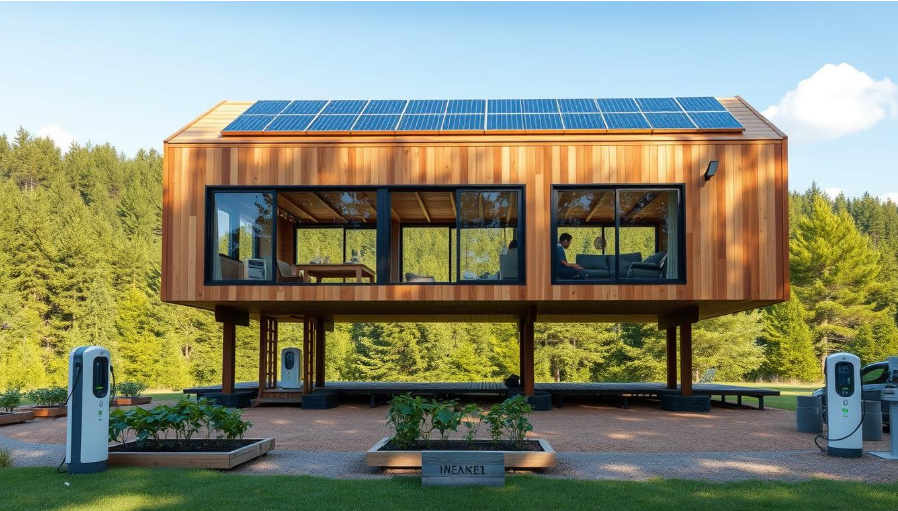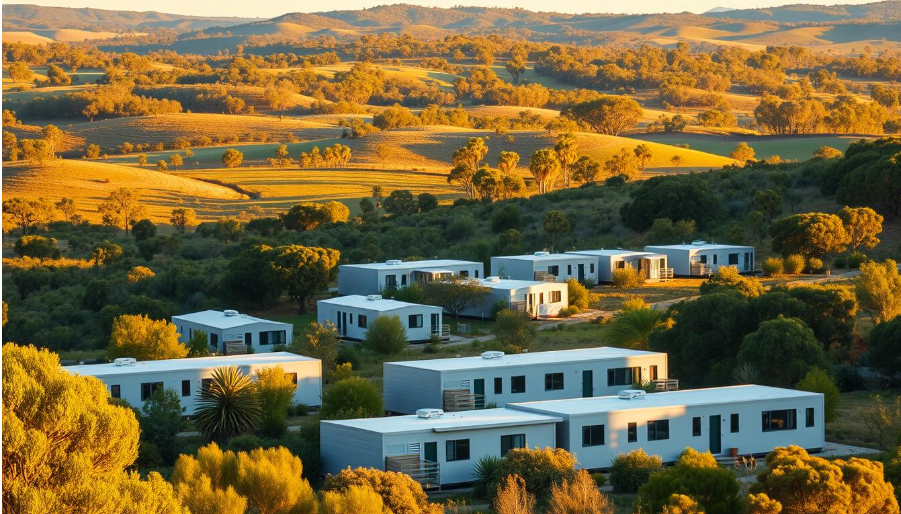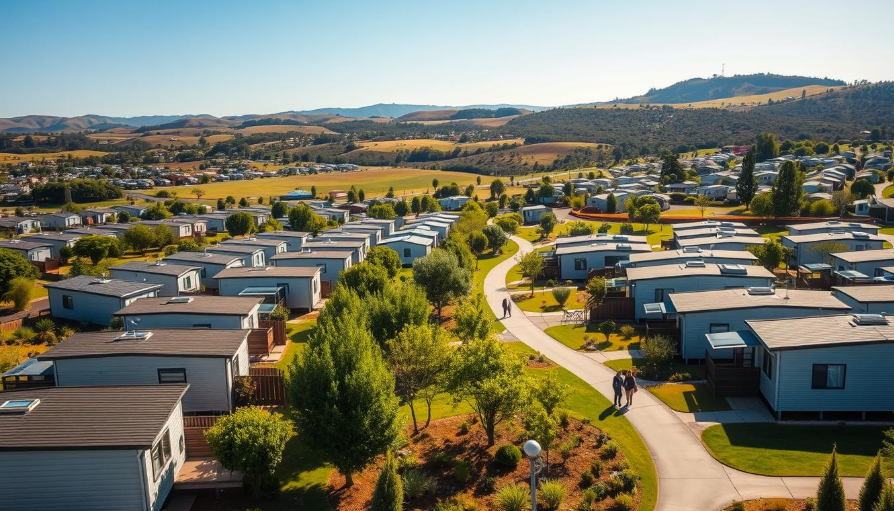Housing prices are going up in Australian cities. Many families are finding a better way to own a home with manufactured homes. These homes are affordable and don’t lose out on quality or style.
Manufactured homes are changing the way we think about homes. They are affordable, well-designed, and built with care. Unlike regular houses, these homes make owning a home possible without a huge cost.
More and more Australians are choosing manufactured homes. They offer a new way to own a home. With modern designs and custom options, they are changing the housing scene.
Key Takeaways
- Manufactured homes provide an affordable housing solution for Australian families
- Modern designs challenge traditional perceptions of prefabricated housing
- Cost-effective approach to property ownership
- High-quality construction meets stringent building standards
- Flexible design options to suit individual preferences
Understanding Modern Manufactured Homes
The world of prefabricated homes has changed a lot in recent years. Modern modular homes are now a smart way to build houses. They are much more advanced than the old mobile homes.
https://www.youtube.com/watch?v=cFUnBFMN09A
Manufactured homes have evolved into top-notch living options. They are now efficient, affordable, and stylish. These modern homes offer great flexibility and quality to homeowners.
From Mobile Homes to Sophisticated Dwellings
The journey of manufactured homes shows big improvements in technology and design:
- Structural strength has improved a lot
- They look better and more stylish
- New materials and building methods are used
- They last longer and are more durable
Quality and Compliance Standards
Today’s modular homes must follow strict building codes and quality standards. Manufacturers follow strict rules to ensure:
- They are safe and strong
- They use less energy
- They go through thorough quality checks
- They meet national building rules
Customisation and Design Innovations
Modern prefab designs let you personalise your home. You can choose from many:
- Interior finishes
- Architectural styles
- Layout configurations
- Smart home technologies
The future of housing lies in flexible, efficient, and personalised living spaces.
These new ideas show how manufactured homes have become a smart, flexible housing option for Australian families today.
The Cost Benefits of Factory-Built Residences
Factory-built homes are changing the Australian housing scene. They offer big savings in cost. Off-site building is a smart choice, giving buyers big financial wins.
The main money-saving points of factory-built homes are:
- Less time to build
- Lower labour costs
- Less waste of materials
- Clear prices upfront
Off-site building beats traditional methods in cost savings. Manufacturers make things faster and cheaper, saving buyers money.
| Construction Method | Average Build Time | Estimated Cost per Square Metre |
| Traditional On-Site Construction | 6-9 months | $2,500 – $3,500 |
| Factory-Built Residences | 8-12 weeks | $1,800 – $2,500 |
Factory-built homes have controlled manufacturing environments. This cuts down on surprise costs. Builders know the costs, making it easier for buyers.
Factory-built homes are a big change for affordable housing in Australia.
Using new off-site building methods, makers can make quality homes at good prices. Buyers get homes built faster, save on labour, and know their costs.
Sustainable Features and Energy Efficiency in Manufactured Homes
Modern transportable homes are changing the game for sustainable living in Australia. They offer smart solutions that are both eco-friendly and stylish. Kit homes lead the way in green housing, helping homeowners cut down on carbon emissions.

Today’s transportable homes focus on green tech and sustainable building. This move shows a growing concern for the environment and saving money in the long run.
Eco-Friendly Building Materials
Kit homes now use advanced materials that are kinder to the planet:
- Recycled steel frameworks
- Sustainable timber from certified forests
- Low-emission insulation materials
- Renewable composite materials
Smart Home Technology Integration
Transportable homes are getting smarter, saving energy:
- Automated climate control
- Solar panel monitoring apps
- Energy usage tracking interfaces
- Remote-controlled smart appliances
Energy-Saving Design Elements
Modern kit homes use clever designs to save energy:
- Passive solar orientation
- Enhanced thermal insulation
- Rainwater harvesting systems
- LED lighting installations
By using these green features, homeowners can greatly reduce their environmental impact. They also get to enjoy modern, cozy homes.

The Australian manufactured housing market is growing fast. It offers affordable housing solutions for many communities. Relocatable buildings are now popular in cities and rural areas, giving people flexible living options.
When looking at manufactured homes, there are important things to think about:
- Regional climate adaptability
- Specific lifestyle requirements
- Budget constraints
- Potential resale value
Top manufacturers in Australia have made homes that meet local needs. Coastal regions need special designs, unlike inland areas. So, it’s vital to research the area you’re interested in.
| Region | Average Cost | Popular Design Features |
| Queensland | $180,000 – $250,000 | Elevated designs, wide verandahs |
| Victoria | $160,000 – $230,000 | Compact layouts, energy-efficient |
| Western Australia | $170,000 – $240,000 | Heat-resistant materials |
It’s smart to work with well-known manufacturers. They know the local building rules and offer great support when you buy.
Land Requirements and Installation Considerations
Setting up manufactured homes needs careful planning. Homeowners must follow several important steps for a smooth installation. Knowing these steps can make the process easier and avoid problems.
Site Preparation Guidelines
Getting the land ready for manufactured homes is key. Homeowners should focus on these steps:
- Do a detailed site survey to check the ground
- Make sure there’s good drainage and stable soil
- Level the ground accurately with special tools
- Build a strong foundation that follows local rules
Council Approval Process
Getting council approval is vital for installing modular homes. Each area has its own rules that homeowners must follow:
- Look up local zoning laws for manufactured homes
- Get the needed building permits
- Send in detailed site plans for council to check
- Follow all structural and environmental rules
Transport and Setup Logistics
The last part of installing manufactured homes is planning the transport and setup. Special teams handle moving these homes safely. They aim to cause little disruption and place the homes accurately.
Careful planning turns the challenge of home installation into a smooth, manageable process.
Professional help can greatly reduce problems during the transport and setup of manufactured homes.
Conclusion
Prefabricated dwellings have changed the way we think about homes in Australia. They offer a smart way to live affordably and sustainably. These homes meet the needs of many Australian families.
Looking into manufactured homes shows us innovation, quality, and practicality. They are energy-efficient and can be customised. This makes them a great choice for those looking for affordable homes.
These homes are built to last and use the latest technology. They are perfect for first-time buyers, those downsizing, and investors. The Australian housing market is changing, and prefab homes are leading the way.
As housing issues continue, prefab homes offer a solution. They provide comfortable, efficient, and stylish living. Australians can now find homes that fit their needs and budget.
FAQ
What exactly is a manufactured home?
A manufactured home is built in a factory and then moved to its final spot. They are made to high standards, making them a modern, affordable choice. You can find them in many sizes and styles, from small to large.
How do manufactured homes differ from traditional mobile homes?
Today’s manufactured homes are much better than old mobile homes. They meet strict building codes and have modern designs. You can also customise them with high-end features and energy-saving tech.
Are manufactured homes a good investment in Australia?
Yes, they are! They’re cheaper than regular houses and take less time to build. This makes them a smart choice for many Australians looking for quality homes at a lower price.
What are the typical costs of a manufactured home?
The price varies based on size, design, and features. But, they’re usually cheaper than traditional houses, costing between $80,000 and $250,000. Building them in a factory saves money on labour and materials.
How long does it take to construct a manufactured home?
Building a manufactured home is quick. It can take 4-8 weeks in the factory. Then, it’s installed in just a few days, making it a fast option.
Can manufactured homes be customised?
Yes, they offer many customisation options. You can pick from different designs, finishes, and features. This lets you create a home that suits your style and needs.
What about council approvals for manufactured homes?
Getting council approval varies by area. It’s important to check local rules, get the right permits, and make sure the home meets building codes. Working with a reputable manufacturer can help with this.
Are manufactured homes energy efficient?
Yes, they are designed to save energy. They often have better insulation, energy-saving appliances, and smart home tech. This can lead to lower bills and less environmental impact.
Can manufactured homes be relocated?
Relocating a home is possible but can be tricky and costly. It depends on the home’s age, condition, and how it was built. It’s wise to get advice from experts before moving.
What maintenance do manufactured homes require?
Maintenance is similar to regular houses. You’ll need to check seals, maintain systems, manage moisture, and do structural checks. Modern homes are built to last, making upkeep easier.

